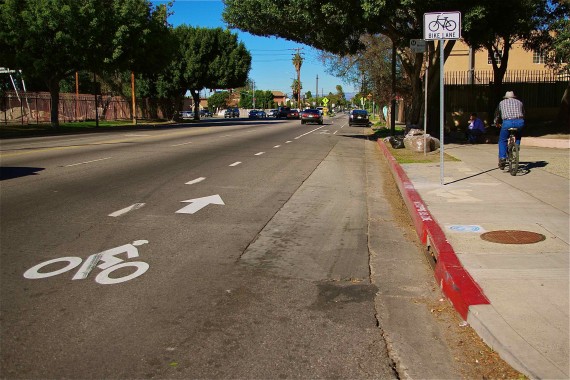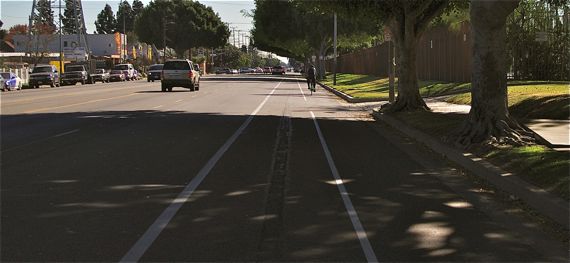
Well, what do you see?
I'm guessing your answer will run along the lines of "a need for education."
But who exactly needs to be educated?
Think for a second.
How many times have you seen a cyclist pedaling happily along a crowded sidewalk, completely uninterested in riding in the wide-open bike lane a few feet from him?
I see it all the time, multiple times a day. Especially downtown, where the green and buffered bike lanes scream, "Ride me! I'm totally here for you!" and many cyclists still choose dodging annoyed pedestrians on packed sidewalks.
These cyclists -- often lower-income commuters and youth -- are trying to tell us something with the choices they make. Namely, bike lanes are not enough to make them feel safe riding in the road.
Some of the fear is merited. In the location in the photo above, for example, drivers looking to branch off onto Hooper St. from Central are loathe to yield to cyclists looking to continue along Central. Trying to hold your lane could end very badly for you.
Other fears are not. Take this stretch of Central -- it is very wide and cyclists have more than enough room. It clearly wasn't enough for the fellow below, however, who rode next to the bike lane (using it as a buffer) in the street. And, he appeared to have only chosen to ride in the road because there is no sidewalk alongside the power station (to his right). Once the sidewalk reappeared a little further south, he was all over it.

Telling cyclists like these men to take a nearby bike-friendly street so that they can ride in peace won't work. Depending on who they are and the area of town they are in, they may not feel safe doing so. Male youth also generally feel safer on busy streets where it is harder to be hassled, caught off guard, or cornered.
Educating the cyclists about bike lanes and explaining that they are there for their use and safety will not be much help, either. The only things that will disabuse them of the notion that "drivers are crazy!" are drivers behaving better and fewer hit-and-runs.
Cyclists I have asked about their riding patterns tell me they are simply afraid to be in the road. Some are not even comfortable along streets like Exposition, a favorite of mine because the bike lane runs adjacent to the curb and cyclists don't have to worry about parked cars and doorings.
If they do ride in the street, they often do so on the wrong side because they feel safer when they are able to see what is coming at them. One youth stopped for riding on the wrong side of Wilmington Ave. told me he complained in vain to the officer that the street was too unsafe for him to ride with traffic, citing incidents where he and others had been hit from behind. Another youth who lives near Vermont and Gage reported having been hit four separate times, with the driver bolting each time. He, too, has been ticketed for riding on the wrong side of the street but still refuses to ride with traffic.
Instead of encouraging better riding habits, enforcement tends to push riders like these youth back onto the sidewalks, where (per my observation) they are more at risk. When cyclists shoot out from a sidewalk to cross through an intersection or a driveway, drivers tend not to see them coming until it is too late.
In short, fear makes it tough out there for a cyclist.
What's the solution?
My concern in raising this issue is that people will see photos like those posted here and walk away with the idea that, if riders are so averse to using the lanes, it might not be worth investing in them in lower-income neighborhoods.
I would prefer people thought about ways to make these very needed infrastructure investments pay off.
For an area like South L.A., that might mean shifting focus away from investments in costly infrastructure for bike-friendly streets (in the South and Southeast planning areas) and looking at installing separated or protected bike lanes along major streets where regular painted lanes are supposed to go in. Or even lanes with some sort of physical marker (like red Solo Cups?) that would serve to make drivers think twice about cutting into a lane and give cyclists a little more peace of mind.
Separated lanes certainly appear to have worked some serious magic in Long Beach -- new data from a year-long study of the separated bike lanes along Third St. and Broadway shows that, not only did ridership increase by 33%, bike accidents decreased by 80% (5 to 1), vehicle accidents decreased by 44% (80 to 45), and vehicle speeds dropped by several miles per hour along both streets. Most notably, the study found, sidewalk riding decreased from 63% to 27% along Third St. and from 70% to 28% along Broadway.
Even though separated lanes have been found to increase safety by huge margins, such changes tend to be limited to congested business districts where there is a high density of cyclists, pedestrians, and vehicles and the goal is to encourage more biking and walking. But what if separated or protected lanes were more widely implemented?
In areas like South L.A., they could help in promoting better riding habits among cyclists while offering them more protection from hit-and-runs -- a widespread problem in the area. The protected lanes could also encourage more families and recreational riders to take to the streets, something that could be helpful in addressing the high rates of obesity and diabetes in the area.
Such bike lanes could also help change people's minds about the significance of bike lanes for their community. It is not unusual to hear some argue that bike lanes are a sign of looming gentrification. Silly as that may sound to some, it isn't hard to understand how the appearance of something in the community that doesn't seem to fit the needs or use patterns of cyclists there could set people wondering about what was afoot. Separated or protected lanes, on the other hand, would likely be seen as a benefit to the existing community and could help encourage more civic engagement from the very groups that advocates have a hard time reaching.
Lanes are costly investments. And, they are far more necessary along major thoroughfares in areas like South L.A. than bike-friendly streets. But if we're going to invest that much money putting them in, it would make sense that they be in a form that people are most likely to use.
Educating ourselves about what makes these cyclists feel safe might be the best place to start.






